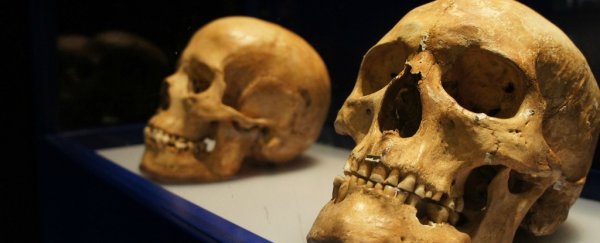Back in the mid-1900's, Portugese neurosurgeon Antonio Egas Moniz 'perfected' the lobotomy - a medical procedure that involved driving a stake into a patient's prefrontal cortex to 'cure' various mental illnesses. Most of the time, these surgeries were carried out with an ice pick-like device without anaesthesia, leaving most patients brain-dead.
While lobotomies are unfortunately still fresh in our collective consciousness, the act of drilling a hole into someone's skull isn't new. In fact, based on a number of 6,000-year-old fossils recently uncovered in Russia, skull surgery might have been used in ritualistic practices long before humans even knew what mental illness was.
Researchers from the German Archaeological Institute have just released a report on the 13 skulls unearthed in southwestern Russia, describing the large holes drilled into the back of them.
It's thought they got there through a process known as trepanation - the surgical opening of the skull for religious or medical purposes. Now isolated to parts of Africa, South America, and Melanesia, trepanation was once a go-to practice for many ancient societies around the world.
The German archaeologists suggest that the Russian skulls once belonged to 10-year-old children, who were likely involved in some kind of spiritual rite of passage into adulthood - though the skull-drilling technique is thought to have been performed to treat everything from headaches to tumours.
Even more shocking than the discovery of the holes themselves in the skulls of children, the team also reports that 11 of these skulls show signs of healing, which means the victims likely lived through the ordeal.
According to Bruce Bower from ScienceNews, this type of surgery was extremely risky, because it required the surgeon to scrape away just enough bone to expose the brain without allowing it to drain or get too heavily damaged.
Plus, it's super-easy for a patient to bleed out if any veins in their neck get accidentally cut in the process. Ancient surgeons likely had solutions to all of these hurdles, though archaeologists are yet to figure out what they are.
 One of the skull holes. Credit: German Archaeological Institute
One of the skull holes. Credit: German Archaeological Institute
After analysing them with X-rays and CT scans, the researchers found no evidence to suggest that the surgeries were performed to treat any sort of medical condition, which is furthered by the location of the holes.
They say that when people were treated for a brain tumour around this time, their skulls were drilled into from the side, not the back. Since these holes do not match common medical practices of the time, the team notes that the surgeries were likely ritualistic in nature.
In a previous report on trepanation by researchers from the University of California, Irvine, it's suggested that these holes might have been used to allow spirits to escape or enter a person.
As the research continues, we'll hopefully find out how these surgeries were performed with limited medical knowledge, and without killing every patient. Ideally, this would involve finding the tools used to perform the procedure.
The team's findings have been published in the American Journal of Physical Anthropology.
